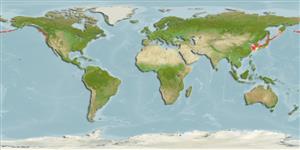Common names from other countries
分類 / Names
俗名 | 同種異名 | Catalog of Fishes(屬, 種) | ITIS | CoL | WoRMS | Cloffa
Teleostei >
Perciformes/Uranoscopoidei (Sand dwellers)
鱸形目 (Sand dwellers) >
Ammodytidae (Sand lances)
玉筋魚科 (Sand lances)
Etymology: Ammodytes: Greek, ammos = sand + Greek, dytes = anyone that likes immersions, diving (Ref. 45335).
More on author: Girard.
Environment: milieu / climate zone / depth range / distribution range
生態學
海洋 居於水底的; 海洋洄游的 (Ref. 51243); 深度上下限 0 - 172 m (Ref. 114018). 溫帶; 54°N - 30°N, 118°E - 118°W
Northwest Pacific: inland Sea of Japan to Kyushu, Japan. Northeast Pacific: From southern California to the western Aleutian Islands (Ref. 114018), Alaska (Ref. 11366).
西北太平洋: 日本到日本北海道的內海。 東北太平洋: 阿拉斯加州.(參考文獻 11366)
大小 / 重量 / 年齡
Maturity: Lm ? range ? - ? cm
Max length : 15.0 cm SL 雄魚/尚未辨別雌雄; (Ref. 559); common length : 10.0 cm SL 雄魚/尚未辨別雌雄; (Ref. 559); 最大體重: 10.60 g (Ref. 112063); 最大年齡: 3.00 年 (Ref. 125612)
背棘 (總數) : 0; 背的軟條 (總數) : 55 - 59; 臀棘: 0; 臀鰭軟條: 28 - 32; 脊椎骨: 62 - 67. Characterized by having a horizontal skin fold along its ventral contour, and the absence of pelvic fin and teeth. Lateral plicae 160 to 180. Lower jaw pointed. Lateral line system on head not continuous with that on the body.
特徵為有一個水平的皮膚摺層沿著它的腹輪廓, 與那缺乏腹鰭與齒。 側面的皺摺 160 到 180. 下頜尖的。 在頭部上的側線系統在身體上不與那續接在一起。
Found in sand bottoms and may enter semi-enclosed sea areas (Ref. 11230). Forms large schools. Important food fish in Japan (marketed fresh or dried) and marketed fresh but mainly used for meal and oil manufacture in Europe (Ref. 10384). Common size taken from picture in Ref. 559. Maximum size estimated as 1.5 * common size. Two genetically different lineages were found in Japan Sea/East Sea, perhaps representing two different species (J.K. Kim, oral.comm, FishBoL2012, June 2012).
發現於砂質底部了而且可能進入半封閉的海洋區域.(參考文獻 11230) 形成大群魚群。 在日本 (在市場上銷售生鮮地或者乾燥的) 的重要食用魚而且在市場上銷售生鮮地但是主要地在歐洲用來了食物與油脂產品.(參考文獻 10384) 普遍的大小參考文獻 559 取自了照片。 最大體長估計如 1.5* 普遍大小。
Life cycle and mating behavior
Maturities | 繁殖 | Spawnings | Egg(s) | Fecundities | 仔魚
西北太平洋: 日本到日本北海道的內海。 東北太平洋: 阿拉斯加州.(參考文獻 11366)
Masuda, H., K. Amaoka, C. Araga, T. Uyeno and T. Yoshino, 1984. The fishes of the Japanese Archipelago. Vol. 1. Tokai University Press, Tokyo, Japan. 437 p. (text). (Ref. 559)
CITES (Ref. 128078)
Not Evaluated
人類使用
漁業: 高經濟性
工具
特別的報告
下載 XML
網路資源
Estimates based on models
Preferred temperature (Ref.
115969): 11.9 - 23, mean 19.1 (based on 74 cells).
Phylogenetic diversity index (Ref.
82804): PD
50 = 0.5156 [Uniqueness, from 0.5 = low to 2.0 = high].
Bayesian length-weight: a=0.01000 (0.00524 - 0.01907), b=3.23 (3.06 - 3.40), in cm Total Length, based on LWR estimates for this species & Genus-body shape (Ref.
93245).
營養階層 (Ref.
69278): 3.1 ±0.1 se; based on size and trophs of closest relatives
回復力 (Ref.
120179): 高度, 族群倍增時間少於 15個月 (K=0.6).
Prior r = 0.79, 95% CL = 0.52 - 1.18, Based on 4 data-limited stock assessments.
Fishing Vulnerability (Ref.
59153): Low vulnerability (14 of 100).
Climate Vulnerability (Ref.
125649): Low vulnerability (17 of 100).
